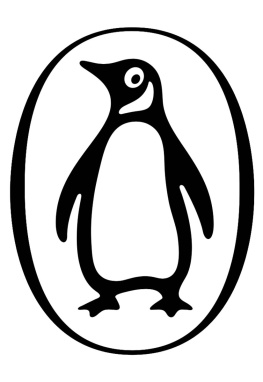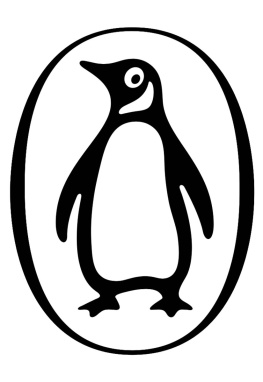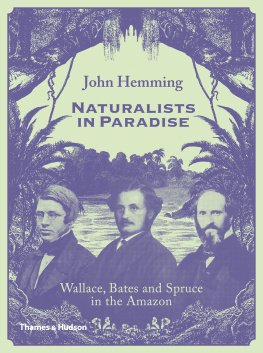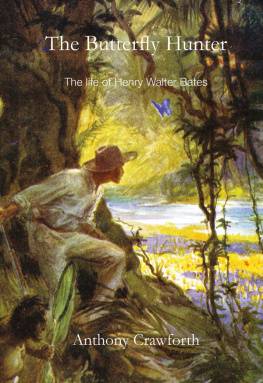In the Heart of the Amazon Forest, 1859
WALTER HENRY BATES
In the Heart of the Amazon Forest

GREAT
JOURNEYS
PENGUIN BOOKS
Published by the Penguin Group
Penguin Books Ltd, 80 Strand, London WC2R 0RL , England
Penguin Group (USA) Inc., 375 Hudson Street, New York, New York 10014, USA
Penguin Group (Canada), 90 Eglinton Avenue East, Suite 700, Toronto, Ontario, Canada M4P 2Y3 (a division of Pearson Penguin Canada Inc.)
Penguin Ireland, 25 St Stephens Green, Dublin 2, Ireland (a division of Penguin Books Ltd)
Penguin Group (Australia), 250 Camberwell Road, Camberwell, Victoria 3124, Australia (a division of Pearson Australia Group Pty Ltd)
Penguin Books India Pvt Ltd, 11 Community Centre, Panchsheel Park, New Delhi 110 017, India
Penguin Group (NZ), 67 Apollo Drive, Mairangi Bay, Auckland 1310, New Zealand (a division of Pearson New Zealand Ltd)
Penguin Books (South Africa) (Pty) Ltd, 24 Sturdee Avenue, Rosebank, Johannesburg 2196, South Africa
Penguin Books Ltd, Registered Offices: 80 Strand, London, WC2R 0RL , England
www.penguin.com
The Naturalist on the River Amazons first published in 1863
This extract published in Penguin Books 2007
All rights reserved
Except in the United States of America, this book is sold subject to the condition that it shall not, by way of trade or otherwise, be lent, re-sold, hired out, or otherwise circulated without the publishers prior consent in any form of binding or cover other than that in which it is published and without a similar condition including this condition being imposed on the subsequent purchaser
ISBN: 978-0-14-196322-8
The extraordinary eleven year residence on the Amazon of Walter Henry Bates (18501918) resulted in a haul of some 15,000 specimens, principally insects, well over half previously unknown to science. It also resulted in one of the most entertaining and evocative of all travel books, The Naturalist on the River Amazons. Journeying up the Amazon (or Amazons as it was then called), initially with Alfred Russel Wallace, Bates had an infinity of attractive adventures with snakes, cockroaches and vampire bats but also became a major scientist, returning to England to become an important supporter of Darwin and to develop the theory of Batesian mimicry, based on his study of Brazilian insects.
The sections here deal with part of his eventful extended stay in Ega (now called Tef), where the river systems of the Amazon (then called on these upper reaches the River Solimoens), the Teffe/Tef and the Japur meet. His companion Antonio Cardozo is the seemingly infinitely obliging Delegado of Police in Ega. Mameluco is a Portuguese word for the offspring of Portuguese and Amerindian parents. Tracajas and Aiyussas are kinds of Amazonian turtle. The mid-river royal islands referred to reflect Brazils being ruled in this period by the Emperor Pedro II.
Blow-guns, Turtle-hunting and Alligators
I will now proceed to give some account of the more interesting of my shorter excursions in the neighbourhood of Ega. The incidents of the longer voyages, which occupied each several months, will be narrated in a separate chapter.
The settlement, as before described, is built on a small tract of cleared land at the lower or eastern end of the lake, six or seven miles from the main Amazons, with which the lake communicates by a narrow channel. On the opposite shore of the broad expanse stands a small village, called Nogueira, the houses of which are not visible from Ega, except on very clear days; the coast on the Nogueira side is high, and stretches away into the grey distance towards the southwest. The upper part of the river Teffe is not visited by the Ega people, on account of its extreme unhealthiness, and its barrenness in sarsaparilla and other wares. To Europeans it would seem a most surprising thing that the people of a civilised settlement, a hundred and seventy years old, should still be ignorant of the course of the river on whose banks their native place, for which they proudly claim the title of city, is situated. It would be very difficult for a private individual to explore it, as the necessary number of Indian paddlers could not be obtained. I knew only one person who had ascended the Teffe to any considerable distance, and he was not able to give me a distinct account of the river. The only tribe known to live on its banks are the Catauishis, a people who perforate their lips all round, and wear rows of slender sticks in the holes: their territory lies between the Purus and the Jurua, embracing both shores of the Teffe. A large, navigable stream, the Bararua, enters the lake from the west, about thirty miles above Ega; the breadth of the lake is much contracted a little below the mouth of this tributary, but it again expands further south, and terminates abruptly where the Teffe proper, a narrow river with a strong current, forms its head water.
The whole of the country for hundreds of miles is covered with picturesque but pathless forests, and there are only two roads along which excursions can be made by land from Ega. One is a narrow hunters track, about two miles in length, which traverses the forest in the rear of the settlement. The other is an extremely pleasant path along the beach to the west of the town. This is practicable only in the dry season, when a flat strip of white sandy beach is exposed at the foot of the high wooded banks of the lake, covered with trees, which, as there is no underwood, form a spacious shady grove. I rambled daily, during many weeks of each successive dry season, along this delightful road. The trees, many of which are myrtles and wild Guavas, with smooth yellow stems, were in flower at this time; and the rippling waters of the lake, under the cool shade, everywhere bordered the path. The place was the resort of kingfishers, green and blue tree-creepers, purple-headed tanagers, and hummingbirds. Birds generally, however, were not numerous. Every tree was tenanted by Cicadas, the reedy notes of which produced that loud, jarring, insect music which is the general accompaniment of a woodland ramble in a hot climate. One species was very handsome, having wings adorned with patches of bright green and scarlet. It was very common sometimes three or four tenanting a single tree, clinging as usual to the branches. On approaching a tree thus peopled, a number of little jets of a clear liquid would be seen squirted from aloft. I have often received the well-directed discharge full on my face; but the liquid is harmless, having a sweetish taste, and is ejected by the insect from the anus, probably in self-defence, or from fear. The number and variety of gaily-tinted butterflies, sporting about in this grove on sunny days, were so great that the bright moving flakes of colour gave quite a character to the physiognomy of the place. It was impossible to walk far without disturbing flocks of them from the damp sand at the edge of the water, where they congregated to imbibe the moisture. They were of almost all colours, sizes, and shapes: I noticed here altogether eighty species, belonging to twenty-two different genera. It is a singular fact that, with very few exceptions, all the individuals of these various species thus sporting in sunny places were of the male sex; their partners, which are much more soberly dressed and immensely less numerous than the males, being confined to the shades of the woods. Every afternoon, as the sun was getting low, I used to notice these gaudy sunshine-loving swains trooping off to the forest, where I suppose they would find their sweethearts and wives. The most abundant, next to the very common sulphur-yellow and orange-coloured kinds, were about a dozen species of Eunica, which are of large size, and are conspicuous from their liveries of glossy dark-blue and purple. A superbly-adorned creature, the Callithea Markii, having wings of a thick texture, coloured sapphire-blue and orange, was only an occasional visitor. On certain days, when the weather was very calm, two small gilded-green species (Symmachia Trochilus and Colubris) literally swarmed on the sands, their glittering wings lying wide open on the flat surface. The beach terminates, eight miles beyond Ega, at the mouth of a rivulet; the character of the coast then changes, the river banks being masked by a line of low islets amid a labyrinth of channels.
Next page














